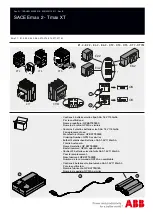
IB 6.2.11.1-2C
Page 12
ABB
continue as follows: With circuit breaker in "OPEN"
position and motor disconnect switch (14) in "OFF"
position, insert racking crank (8) in opening and press
down drawout lever (11). Rotate the racking crank
clockwise until lever (11) moves up and cranking is
automatically stopped. Breaker is now in
"CONNECTED" position. Excessive cranking force
indicates misalignment or interference of parts.
Manual Closing Operation
The following manual closing procedures are
recommended (See Figure 1 )
a. Observe circuit breaker conditions on control
escutcheon.
b. If closing springs are discharged, manually charge
closing springs by means of the manual charge lever
(16).
c. If springs are charged, pull the manual close lever
(12) by means of a lanyard from a safe distance.
d. For partially charged closing springs, should closing
not occur upon pulling the manual close lever, continue
charging until closing springs are completely charged
(heard to snap and by visual indicator (6)), then pull
manual close lever (12) by means of a lanyard from a
safe distance.
Circuit Breaker Removal (See Figure 1)
a. Trip circuit breaker by any tripping means.
b. Open front compartment door.
c. Engage racking crank (8) in opening and push
drawout lever (11) down. Rotate racking crank
counterclockwise until racking mechanism
automatically stops at “TEST" position. Lower track
extensions.
d. Repeat step "C" to rack circuit breaker to
"DISCONNECT" position.
e. Depress drawout lever (11) and continue cranking
counterclockwise as far as stops will allow. (Do not
force beyond stops.)
f. Pull circuit breaker torward to fully extended position.
(Should the circuit breaker be charged, closing springs
will automatically be discharged at this point.)
g. Remove circuit breaker from tracks with lifting yoke,
then raise tracks into compartment and close door.
MAINTENANCE AND ADJUSTMENTS
SAFETY NOTES
When it is necessary that the charging springs be
charged, or the circuit breaker be closed, make sure to
stay clear of operating parts.
Breakers shouId be withdrawn to "TEST" position for
checking the breaker operation. For further inspection,
adjustments, cleaning or replacement of parts, the
circuit breaker should be withdrawn from the cell and
moved to a suitable area.
Periodic Maintenance Inspection
The safety and successful functioning of the connected
apparatus depends upon the proper operation of the
circuit breaker. Therefore, it is recommended that a
maintenance program be established that will provide
for a periodic inspection of the circuit breaker after 250
no load or load current switching operations.
It is recommended that the circuit breaker be inspected
after the first 250 operations and on a yearly basis
unless enviromental considerations and operating
experience indicate that more frequent inspections are
appropriate. The circuit breaker should also be
inspected after a short circuit or severe overload
interruption, regardless of time period or number of
operations.
Where unusual service conditions, as covered by ANSI
C37.13, exist, it is assumed that these conditions were
considered at the time of order, and that special
maintenance procedures are in place accordingly.
These maintenance instructions only cover circuit
breakers used under the Standard’s normal service
conditions.
The inspection should include opening and closing the
circuit breaker electrically and manually. The unit
should be visually inspected for loose or damaged
parts. Arc chutes, contacts and insulation structure
should be inspected as described below.
WARNING WARNING WARNING WARNING
DE-ENERGIZE BOTH PRIMARY AND CONTROL
CIRCUITS BEFORE MAKING ANY INSPECTIONS,
ADJUSTMENTS, OR REPLACEMENTS OF PARTS.
MAKE CERTAIN BREAKER IS OPEN BY
OBSERVING INDICATOR (2, FIGURE 1), AND
CLOSING SPRINGS ARE NOT CHARGED BY
OBSERVING INDICATOR (6, FIGURE 1).



































